|
|
ARTHROPODS:
Insects»
Spiders»
Centipedes»
Millipedes»
Sowbugs»
Harvestmen»
Mites
& Ticks»
Scorpions»
Identification
Tips»
About
the Critter Files»
Links» |
|
|
|
 |
ORB-WEAVER
SPIDERS
Critter
Files/Spiders/Orb-Weaver Spiders
By Blake Newton
University of Kentucky Department of Entomology |
| |
|
| Orb
Weavers are difficult to distinguish from other kinds of
spiders that live in webs, especially cobweb
spiders. |
|
| The best way to tell
the difference between orb weavers and cobweb spiders is by looking
at the web itself: the webs made by orb-weavers are very organized,
and resemble a circular grid. The webs of cobweb spiders appear
disorganized and messy. Orb weavers have 8 eyes, and they
usually have large spherical abdomens. Like all spiders, orb
weavers have 8 legs, 2 body parts, and fang-like mouthparts called
"chelicerae." |
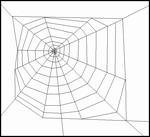 Typical Orb Web
Typical Orb Web |
|
| SIZE:
Body length up to about 1/2" |
| |
| LIFE
CYCLE |
|
Simple
metamorphosis: like all spiders, young orb-weaver spiders hatch
from eggs and look like tiny adults. They shed their skin
as they grow. Many Kentucky orb weavers only live for one year or less. At
the end of the summer, many female orb weaver species produce a large amount
of eggs (sometimes hundreds) that they wrap in a silken egg case.
The young spiders hatch in the spring. |
| ECOLOGY |
|
Orb weavers are very
common in Kentucky, and can be found almost anywhere. They
need weeds, fences, trees, walls, or other upright structures to
build their webs. Orb weavers will eat almost anything small
enough to get trapped in their webs, especially small insects and
other spiders. Like many web-building spiders, orb weavers
tend to have poor vision: they don't need to see very well to hunt
because they can "feel" whenever prey gets caught in their
webs. |
| |
| PEST
STATUS |
|
Orb-weaver
spiders are considered beneficial to humans. They eat flies,
mosquitoes, ants, and other pest insects. Although many can
give a painful bite, no Kentucky orb-weaver spiders are considered
dangerous to humans (except to rare individuals who have severe
allergic reactions to insect and spider bites).
|
| |
| COMMON
KENTUCKY ORB WEAVERS |
|
| We have many
species of orb weavers in Kentucky. Although most of them are
similar in shape, orb-weaver spiders come in a wide variety of colors
and patterns. Shown below are some of the most common and distinctive
orb-weavers. |
|
|
BLACK
AND YELLOW ARGIOPE
GENUS and SPECIES:
Argiope aurantia
One of Kentucky's largest
spiders is an orb weaver called the Black and Yellow Argiope,
Argiope aurantia, pictured below. Commonly called
"garden spiders," these orb weavers can be almost 3 inches
long from leg tip to leg tip. Argiope spiders are
very common in backyard gardens, and have given a fright to many
a homeowner. Although they are large and intimidating, their
bite is only dangerous to people who experience severe allergic
reactions to insect and spider bites. The picture below was
sent to us by Mindy Crosby from Louisville, KY.
Argiope spiders
are also called "writing spiders" because of the bold
zigzag pattern that they build into their web. This webpage
from the University of Michigan has lots of detailed info about
Argiope spiders. |
| |
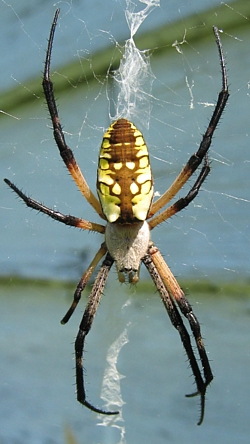 Black
& Yellow Argiope, Argiope aurantia (M. Crosby, 2006)
Black
& Yellow Argiope, Argiope aurantia (M. Crosby, 2006) |
|
|
|
MARBLED
SPIDER
GENUS and SPECIES:
Araneus marmoreus
Pictured below is the
Marbled Spider, Araneus marmoreus. This
large, colorful spider is common in urban areas, and is over 1/2"
long. |
| |
 The
Marbled Spider, Araneus marmoreus (R. Bessin, 2000)
The
Marbled Spider, Araneus marmoreus (R. Bessin, 2000) |
|
|
|
STAR-BELLIED
SPIDER
GENUS and SPECIES:
Acanthepeira stellata
Shown below is a common
orb-weaver called the Star-Bellied Spider, Acanthepeira
stellata (1/2"). It was photographed in a meadow
at the Buckley Wildlife Sanctuary in Franklin County, Kentucky.
|
| |
 Star-Bellied
Spider (B. Newton, 2003)
Star-Bellied
Spider (B. Newton, 2003) |
|
|
|
Micrathena
spp.
GENUS: Micrathena
Orb-weaver spiders in
the Micrathena genus are known for their
distinctive spikes and vibrant colors. The
Arrowshaped Micrathena and the Spined Micrathena
are about 1/2" long and are common in meadows, along the edges
of forests, and along woodland trails in Kentucky. The White
Micrathena is smaller, at about 1/4". It is also
common on trails and in meadows. All of these spiders are
notorious for weaving their webs at face-level along trails.
|
| |
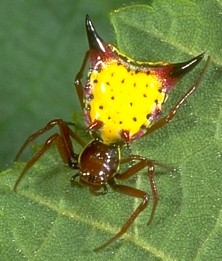 Arrowshaped
Micrathena, Micrathena sagittata
Arrowshaped
Micrathena, Micrathena sagittata
(R. Bessin, 2003) |
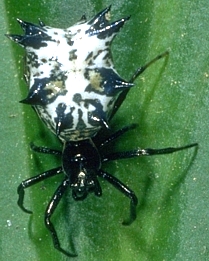 Spined
Micrathena, Micrathena gracilis
Spined
Micrathena, Micrathena gracilis
(R. Bessin, 2003) |
| |
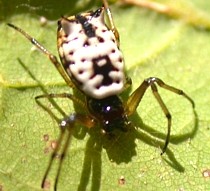 White
Micrathena, Micrathena mitrata (B. Newton, 2005)
White
Micrathena, Micrathena mitrata (B. Newton, 2005) |
|
|
|
FURROW
SPIDERS
GENUS:
Larinoides
Furrow Spiders are common orb-weaver spiders often found around
homes and other urban areas. Some furrow spiders are known to
overwinter as adults: this is noteworthy because typical orb weaver species live for only one season,
dying before winter. Several species of furrow spiders live in Kentucky and they all look very similar. Furrow spiders formerly belonged to the genus Nuctenea, but now belong to the genus Larinoides. These species grow to about 1/2"
long.
|
| |
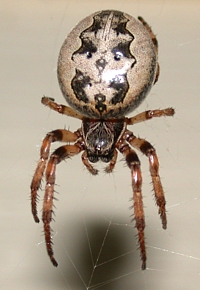 A Furrow
Spider (B. Newton, 2003)
A Furrow
Spider (B. Newton, 2003) |
|
|
|
Acacesia
hamata
GENUS and SPECIES:
Acacesia hamata
Pictured below is a colorful
orb-weaver, Acacesia hamata (1/8"). It was photographed on Queen Anne's Lace at the Raven Run
Nature Sanctuary in Fayette County.
|
| |
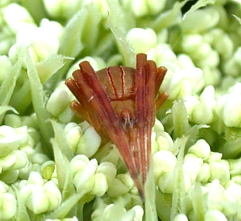 Acacesia
hamata (B. Newton, 2003)
Acacesia
hamata (B. Newton, 2003) |
|
|
|
Cyclosa
spp.
GENUS: Cyclosa
Orb weavers in the Cyclosa
genus have a unique cone-shaped abdomen. These spiders (sometimes called "Trashline Orbweavers") maintain
a line of debris in their webs (consisting of dead prey and shed-skin)
and camouflage themselves among the debris when threatened. The
one pictured below was about 1/4" long and was photographed
in the Floracliff Nature Sanctuary in Fayette Co., Kentucky.
|
| |
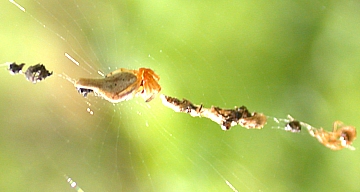 Cyclosa
sp. (B. Newton, 2005)
Cyclosa
sp. (B. Newton, 2005) |
|
|
|
Gea
heptagon
GENUS and SPECIES:
Gea heptagon
Gea heptagon
is about 1/4" long with a bold color pattern and distinctive
spines on the abdomen. A female is pictured below. Males
have a similar shape, but are patterned with red and orange. A
male Gea heptagon
is pictured at Bugguide.net.
|
| |
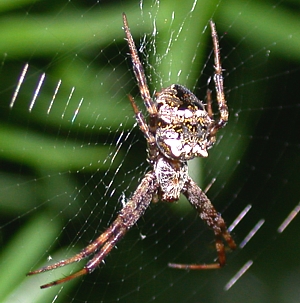 Gea
heptagon female (B. Newton, 2004)
Gea
heptagon female (B. Newton, 2004) |
|
|
|
Arrowhead
Spider
GENUS: Verrucosa
arenata
The Arrowhead
Spider, Verrucosa arenata, is common in Kentucky
forests and meadows. It is a little less than 1/2" long
and has a distinct white or yellow triangular pattern on the abdomen.
Like orb-weavers in the Micrathena
genus (pictured above), Arrowhead Spiders are notorious for building
webs across forest trails at face-level.
|
| |
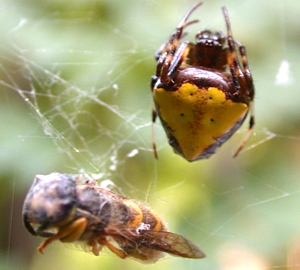 The
Arrowhead Spider, Verrucosa arenata (B. Newton, 2005)
The
Arrowhead Spider, Verrucosa arenata (B. Newton, 2005) |
|
|
|
Neoscona
spp.
GENUS: Neoscona
Orb-weavers in the Neoscona
genus are usually large, about 1/2" long or longer. They
are commonly seen around buildings in the late summer and fall in
Kentucky and they are sometimes called "barn spiders" or "spotted orb weavers". The one below was photographed in Lexington, KY,
by Fred Fahmy, who has kindly allowed us to use the image here. Also pictured is a view from the underside of a spider from this genus (photo by Jim Occi, used with permission from www.bugwood.com).
|
| |
 Neoscona
sp. (F. Fahmy, 2006)
Neoscona
sp. (F. Fahmy, 2006) |
|
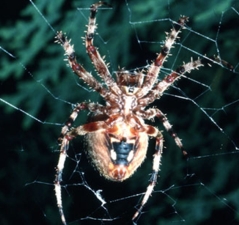 Neoscona
sp., underside (J. Occi, 2004)
Neoscona
sp., underside (J. Occi, 2004) |
|
|
|
BOLAS
SPIDERS
GENUS: Mastophora,
others
Bolas Spiders,
like the one pictured below, are also in the orb-weaver family.
However, they do not build typical orb webs. Instead of waiting
for an insect to get trapped in a web, bolas spiders use chemicals
to attract their prey. When a victim get close enough, a bolas
spider slings a sticky wad of webbing (just like a "bolas"
used by human hunters) with its front legs and snags its prey right
out of the air. Scientists at the University of Kentucky Department
of Entomology have been studying bolas spiders for years. Read
more about this research here.
|
| |
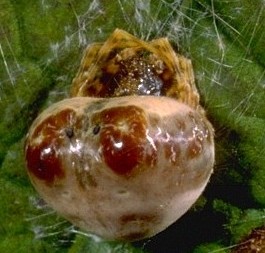 Bolas
spider, Mastophora sp. (R. Bessin, 2000)
Bolas
spider, Mastophora sp. (R. Bessin, 2000) |
|
| |
| COLLECTING
& PHOTOGRAPHY |
|
Orb weavers can be
found almost anywhere, indoors and outdoors. Orb weavers and
cobweb spiders tend to inhabit similar types of environments, although
orb weavers may be more common in wild areas than they are around
buildings and other places where people live. If you are careful,
an orb-weaver will remain still in its web for a photograph as long
as you don't disturb it. Like all spiders, orb-weavers should
be preserved in alcohol.
|
| |
| ORB-WEAVER
FACTS |
|
True orb-weavers (Araneidae)
and long-jawed orb-weavers
(Tetragnathidae) are the only common kinds of Kentucky spiders that make
orb webs. The webs of most other kinds of spiders, such as
cobweb spiders, appear messy
and disorganized.
|
| |
| MYTHS
- LEGENDS - FOLKLORE |
|
Casey Hauser from Winston-Salem,
North Carolina, sent us this urban legend about writing spiders:
"I was always told when I was younger to never say your name
or the name of a loved one around these spiders because any name
they heard they would write in their web and that person would die."
We had never heard this one before, but it is very interesting
(and creepy). Thanks, Casey!
Donna Welch from Abbeville,
South Carolina, was told as a child that that a person will die
if a writing spider "counts your teeth." This saying
is also associated with millipedes.
We hope it is not true for either organism!
Do you know any myths,
legends, or folklore about orb-weaver spiders? If so, let us know.
|
Original document: 25 May 2004
Last updated: 12 Feb 2010
Photos courtesy R.
Bessin and B. Newton, University of Kentucky, except where otherwise noted.
The Kentucky Critter Files are maintained
by Blake Newton, Department of Entomology, University of Kentucky.
Contact: blaken@uky.edu
|
|

